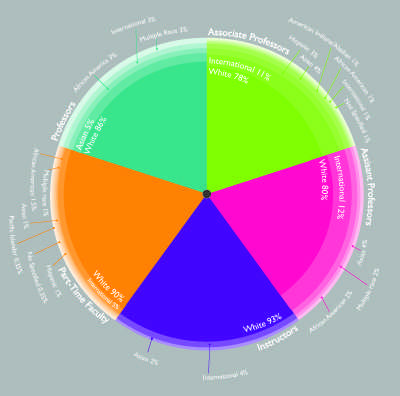Majority of faculty categorized as white
The lack of diversity at USI is not only present in the student body, but the diversity in the faculty is also struggling.
In 2012, 86 percent of professors, 78 percent of associate professors, 80 percent of assistant professors, 93 percent of instructors and 90 percent of part-time faculty were all categorized as white.

The university’s mission statement states USI is a community “enhancing civic and cultural awareness,” and its goal is to “prepare individuals to live wisely in a diverse and global community”.
When Linda Bennett became USI president in 2009, a five-year strategic plan was set with key goals to push the university in the right direction. One of the goals includes increasing “the diversity of faculty, staff and the student body” and is number one in the plan. In 2013, the university is still trying to reach this goal.
“The university is working without question towards this goal for our campus and the greater community,” Provost Ron Rochon said.
Faculty and staff live not only on campus but also in the surrounding areas, and a big concern is how they are received by the community, Rochon said.
The university is currently working with local leaders to help carry out this goal, he said.
“I do believe students deserve the best opportunity to hear and learn from diverse perspectives, diverse voices and diverse narratives,” Rochon said. “It’s going to make you the best professional, so when you leave campus you are prepared for a global community.”
It’s not just about getting faculty to come to USI – It is more about retaining people and a major effort is on the community as well as the university, Rochon said.
“Many folks in the community believe that these individuals would never want to live here in the first place,” Rochon said. “I’m trying to get people to rethink this narrative completely and … put forward the best recruitment package possible.”
The recruitment package contains the best description of what the university has to offer, he said.
“Diversity is not just about faces and numbers,” Rochon said. “It is really about community. That growth may be challenging, but it is necessary.”
The university is still trying to create a more diverse atmosphere, but it has made strides up to now, he said.
Gender is another major diversity issue, and USI has improved, he said.
“I was the first woman to join my department,” Ronda Priest, chair of sociology, anthropology, and criminal justice studies, said.
She said she wondered if there was a place for her when she came to USI.
“We have a woman president now,” she said. “We really have made strides.”
She said to attract more diverse applicants, the university starts with the rigorous hiring process. The process is standard for most universities, and USI isn’t any different.
Advertisements are released in places like The Chronicle of Higher Education and interested potential faculty apply, she said.
Applications are first based on what they can bring to the university, rather than race, she said.
“We really try to judge these applications based on the area of expertise and what they can bring,” Priest said. “We try to look at the whole package.”
She said the university is able to place ads in more diverse places, at a relatively low cost, but race is not the major concern in hiring.
In theory, if two exact races were tied in the hiring process the position would be given to the more diverse applicant, she said. This exact tie has never happened.
“Non-diversity tends to attract non-diversity,” Priest said. “But ‘how do you break away from that?’ is the age-old question.”
Some students come to USI and do not see much diversity.
“At this point I’m used to being the only black person,” freshman Stephanie Milan said.
The nursing major who attended Signature School, a charter high school in Evansville, is used to not seeing many people like her, but she is also ready for something different.
“I get we’re in Evansville, but dang!” she said. “I feel we should have more. I don’t think it’s going to change.”


